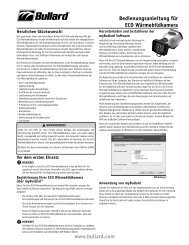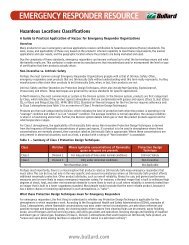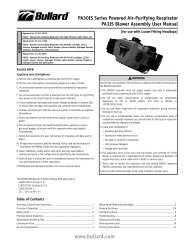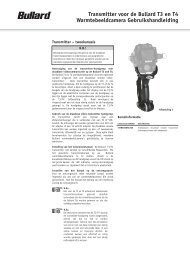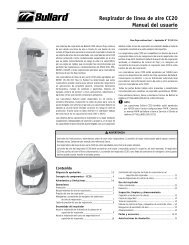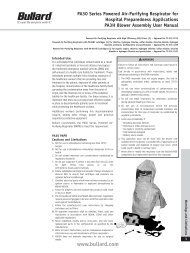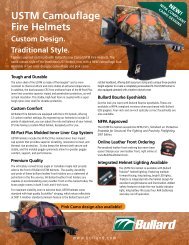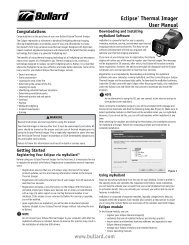RT Series Respirator Hood User Manual www.bullard.com
RT Series Respirator Hood User Manual www.bullard.com
RT Series Respirator Hood User Manual www.bullard.com
Create successful ePaper yourself
Turn your PDF publications into a flip-book with our unique Google optimized e-Paper software.
Breathing Tube<br />
Inspection<br />
Inspect the breathing tube for tears, cracks, holes, or excessive wear that<br />
might reduce the degree of protection originally provided. If any signs of excessive<br />
wear are present, replace the breathing tube immediately or remove<br />
the respirator from service.<br />
Cleaning<br />
To clean the breathing tube, hand-sponge with warm water and mild detergent,<br />
being careful not to get water inside. Rinse and air-dry. After cleaning,<br />
once again carefully inspect breathing tube for signs of damage.<br />
Flow Control Valve/<br />
Climate Control Device<br />
Inspection<br />
Be sure the hose thread is screwed tightly into the breathing tube so no air<br />
can escape during use. Check the adjustment knob on the flow control device<br />
for cracks and other damage.<br />
Cleaning<br />
To clean, hand-sponge with warm water and mild detergent, being careful<br />
not to get water inside. After cleaning, once again carefully inspect breathing<br />
tube for signs of damage. If any signs of excessive wear are present, replace<br />
the flow control valve/climate control device or remove the respirator from<br />
service.<br />
WARNING<br />
Do not cut or remove the foam that is inside the <strong>RT</strong> <strong>Series</strong> Airline<br />
<strong>Respirator</strong> breathing tube. The foam helps reduce the noise level of<br />
the in<strong>com</strong>ing air supply. It does not filter or purify your breathing air.<br />
NIOSH has approved this respirator with the foam in place. Failure to<br />
follow these instructions may result in minor or moderate injury and/or<br />
equipment damage.<br />
<strong>www</strong>.<strong>bullard</strong>.<strong>com</strong><br />
<strong>RT</strong> <strong>Series</strong> <strong>Respirator</strong> <strong>Hood</strong><br />
<strong>User</strong> <strong>Manual</strong> for use with supplied air respirators<br />
Air Supply Hoses<br />
Inspection<br />
Air supply hose(s) should be inspected closely for abrasions, corrosion, cuts,<br />
cracks and blistering. Be sure the hose fittings are crimped tightly to the hose<br />
so that no air can escape. Make sure the hose has not been kinked or crushed<br />
by any equipment that may have rolled over it.<br />
If any of the above signs are present or any other signs of excessive wear<br />
are detected, replace the hose(s) immediately or remove the respirator from<br />
service.<br />
Cleaning<br />
The air supply hose(s) should be hand-sponged with warm water and mild<br />
detergent, rinsed and air dried. Do not get water inside the air supply hose.<br />
After cleaning, once again carefully inspect air supply hose(s) for signs of<br />
damage.<br />
WARNING<br />
Only use air supply hoses that are NIOSH approved for use with the <strong>RT</strong><br />
<strong>Series</strong> respirator. Other hoses could reduce airflow and protection, and<br />
expose the wearer to life-threatening conditions. Failure to follow these<br />
instructions could result in death or serious injury.<br />
Storage<br />
After reusable respirator <strong>com</strong>ponents have been cleaned and inspected, place<br />
them in a plastic bag or an airtight container.<br />
Store the respirator and parts where they will be protected from contamination,<br />
distortion and damage from elements such as dust, direct sunlight, heat,<br />
extreme cold, excessive moisture and harmful chemicals. Five-year maximum<br />
shelf life.<br />
Inspection Cleaning and Storage<br />
9



